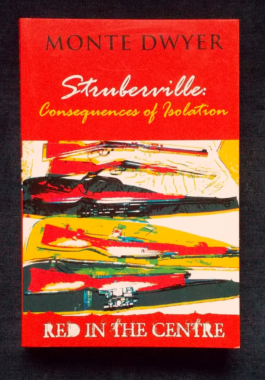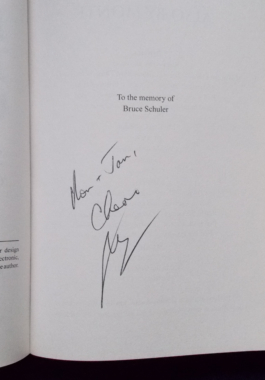-
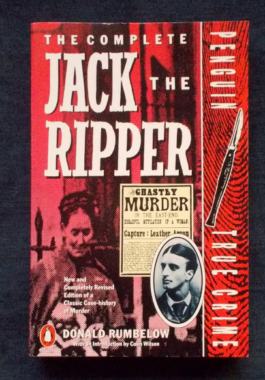 With the advantage of access to some of Scotland Yard's most confidential papers, Donald Rumbelow lays out all the evidence in the most comprehensive summary ever written about the Ripper. Rumbelow, a former London Metropolitan policeman, and an authority on crime, has subjected every theory – including those that have emerged in recent years – to the same deep scrutiny. He also examines the mythology surrounding the case and provides some fascinating insights into the portrayal of the Ripper on stage and screen and on the printed page. More seriously, he also examines the horrifying parallel crimes of the Düsseldorf Ripper and the Yorkshire Ripper in an attempt to throw further light on the atrocities of Victorian London.
With the advantage of access to some of Scotland Yard's most confidential papers, Donald Rumbelow lays out all the evidence in the most comprehensive summary ever written about the Ripper. Rumbelow, a former London Metropolitan policeman, and an authority on crime, has subjected every theory – including those that have emerged in recent years – to the same deep scrutiny. He also examines the mythology surrounding the case and provides some fascinating insights into the portrayal of the Ripper on stage and screen and on the printed page. More seriously, he also examines the horrifying parallel crimes of the Düsseldorf Ripper and the Yorkshire Ripper in an attempt to throw further light on the atrocities of Victorian London. -
 Neighbors were unaware of what went on behind the tightly closed doors of a house in Fresno, California - the home of the imposing, 300-pound Marcus Wesson, his wife, children, nieces and grandchildren. But on March 12, 2004, gunshots were heard inside the Wesson home and police officers, responding to what they believed was a routine domestic disturbance, were horrified by the senseless carnage they discovered when they entered. This is a chilling true story of incest, abuse, madness and murder - it is one family's terrible and ultimately fatal ordeal at the hands of a powerful, manipulative man - a cultist who envisioned vengeful gods and vampires, and totally controlled those closest to him before their world came to a brutal and bloody halt. Illustrated with black and white photos.
Neighbors were unaware of what went on behind the tightly closed doors of a house in Fresno, California - the home of the imposing, 300-pound Marcus Wesson, his wife, children, nieces and grandchildren. But on March 12, 2004, gunshots were heard inside the Wesson home and police officers, responding to what they believed was a routine domestic disturbance, were horrified by the senseless carnage they discovered when they entered. This is a chilling true story of incest, abuse, madness and murder - it is one family's terrible and ultimately fatal ordeal at the hands of a powerful, manipulative man - a cultist who envisioned vengeful gods and vampires, and totally controlled those closest to him before their world came to a brutal and bloody halt. Illustrated with black and white photos. -
 The Mafia murders that stunned Italy and how the killers were brought to justice...On 23 May 1992, the Mafia murdered its 'Number One Enemy', prosecutor Judge Falcone, with a motorway bomb that also killed his wife and three bodyguards. Fifty-seven days later, the Mafia also murdered Falcone's friend and colleague, Judge Borsellino, with a car bomb outside his mother's home that also killed five bodyguards. These murders changed forever the way that Italy views the Mafia. Based on interviews and the testimony of investigators, Mafia super grasses, survivors, relatives and friends, Vendetta recounts how the Mafiosi planned and carried out the murders and how the police hunted them down. Illustrated with black and white photographs.
The Mafia murders that stunned Italy and how the killers were brought to justice...On 23 May 1992, the Mafia murdered its 'Number One Enemy', prosecutor Judge Falcone, with a motorway bomb that also killed his wife and three bodyguards. Fifty-seven days later, the Mafia also murdered Falcone's friend and colleague, Judge Borsellino, with a car bomb outside his mother's home that also killed five bodyguards. These murders changed forever the way that Italy views the Mafia. Based on interviews and the testimony of investigators, Mafia super grasses, survivors, relatives and friends, Vendetta recounts how the Mafiosi planned and carried out the murders and how the police hunted them down. Illustrated with black and white photographs. -
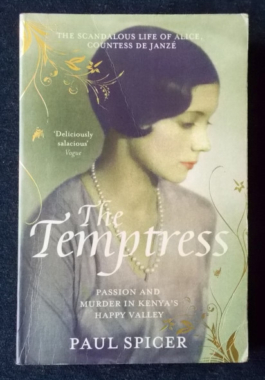 Alice de Janzé, glamorous American heiress, scandalised 1920's Paris when she left her aristocratic French husband for an English lover - whom she later tried to kill in a failed murder-suicide in the Gare du Nord. Abandoning Paris for the moneyed British colonial society known as Kenya's Happy Valley, she became the lover of the handsome womaniser, Joss Hay, Lord Erroll. In 1941, Erroll was found shot in his car on an isolated road. A cuckolded husband was brought to trial and acquitted... and the crime remained tantalizingly unsolved. The author's mother was one of Alice's confidantes, and after his mother's death found a wealth of Alice's personal letters, photographs and sketches. He began researching extensively to piece together what really happened that fateful evening and moreover, brings to life an era of unimaginable wealth and indulgence, where people changed bed partners as easily as they would order a cocktail and where jealousy and hidden passions brewed.This may be the solution of the murder of Lord Erroll.
Alice de Janzé, glamorous American heiress, scandalised 1920's Paris when she left her aristocratic French husband for an English lover - whom she later tried to kill in a failed murder-suicide in the Gare du Nord. Abandoning Paris for the moneyed British colonial society known as Kenya's Happy Valley, she became the lover of the handsome womaniser, Joss Hay, Lord Erroll. In 1941, Erroll was found shot in his car on an isolated road. A cuckolded husband was brought to trial and acquitted... and the crime remained tantalizingly unsolved. The author's mother was one of Alice's confidantes, and after his mother's death found a wealth of Alice's personal letters, photographs and sketches. He began researching extensively to piece together what really happened that fateful evening and moreover, brings to life an era of unimaginable wealth and indulgence, where people changed bed partners as easily as they would order a cocktail and where jealousy and hidden passions brewed.This may be the solution of the murder of Lord Erroll. -
 London, 1910 - the city is rocked by its first encounter with foreign gangsters. In December, a group of Russian anarchists were surprised while burgling a jeweller's shop in Houndsditch. They shot and killed three policemen and wounded two others. Within two weeks, most of the gang had been captured. Then the police were informed that the last two members of the gang were hiding at 100 Sidney Street. The police called in the military, local residents were evacuated and the firefight raged for six hours, culminating in the burning of the house and the discovery of the two agitators' bodies in the ruins. On New Year's Day, Leon Beron, a middle-aged Russian Jew, was found battered to death on Clapham Common. Knife cuts on his cheeks, inflicted after death, formed the shape of a rough 'S' - rumour said it was the revenge murder of an informer, 'S' being the initial letter for 'spy' in both Russian and Polish. Steinie Morrison, who had been seen in his company the night before, was arrested and charged with Beron's murder, and sentenced to hang. This was later commuted to life in prison. Morrison protested the change of sentence and for the next ten years, demanded that the original sentence be carried out, proclaiming his innocence and staging hunger strikes. He never changed his story, not even by the smallest detail, and died ten years later in prison. Was an innocent man convicted? And did the murder of Beron have any connection to the Siege of Sidney Street? With black and white photographs.
London, 1910 - the city is rocked by its first encounter with foreign gangsters. In December, a group of Russian anarchists were surprised while burgling a jeweller's shop in Houndsditch. They shot and killed three policemen and wounded two others. Within two weeks, most of the gang had been captured. Then the police were informed that the last two members of the gang were hiding at 100 Sidney Street. The police called in the military, local residents were evacuated and the firefight raged for six hours, culminating in the burning of the house and the discovery of the two agitators' bodies in the ruins. On New Year's Day, Leon Beron, a middle-aged Russian Jew, was found battered to death on Clapham Common. Knife cuts on his cheeks, inflicted after death, formed the shape of a rough 'S' - rumour said it was the revenge murder of an informer, 'S' being the initial letter for 'spy' in both Russian and Polish. Steinie Morrison, who had been seen in his company the night before, was arrested and charged with Beron's murder, and sentenced to hang. This was later commuted to life in prison. Morrison protested the change of sentence and for the next ten years, demanded that the original sentence be carried out, proclaiming his innocence and staging hunger strikes. He never changed his story, not even by the smallest detail, and died ten years later in prison. Was an innocent man convicted? And did the murder of Beron have any connection to the Siege of Sidney Street? With black and white photographs. -
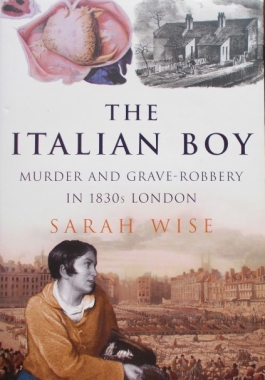
The Italian Boy: Sarah Wise
$30.00At the end of 1831, authorities unearthed a series of crimes at 3 Novia Scotia Gardens that appeared to be a copycat of the infamous Burke and Hare killings in Edinburgh only three years earlier. Soon three body-snatchers were on trial for providing the anatomy schools of London with suspiciously fresh bodies for dissection. They became famous as the London Burkers and their story was dubbed "The Italian Boy" case. The ensuing uproar forced legislation to end body-snatching in Britain. As well as covering the actual case, this book is a fascinating window on the lives of the poor of 1830s London. -
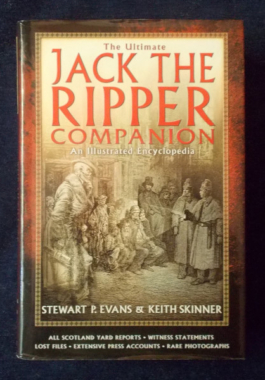 This really is the ultimate for Ripperologists - an encyclopedic work, solidly researched and profusely illustrated, collated from all the known and still-existing official records and supplemented by contemporary press reports. It presents. for the first time in one volume, a prime-source reference book on the eleven shocking prostitute murders that took place in the East End of London between 1888 and 1891. While there is no doubt that the Whitechapel Murders, as they were classified by Scotland Yard, were committed by more than one person, no one knows how many of the killings can be attributed to a single culprit. More than one murderer wore the guise of Jack the Ripper, and the identities of all suspects to this day remain unknown. Divorcing the facts of the Ripper case from the myths that have proliferated in fiction and film, this is a factual, documented narrative of the entire series of crimes, their forensic evidence, the official suspects and possible accomplices, police reports, inquests, newspaper articles of the day and rare photographs.
This really is the ultimate for Ripperologists - an encyclopedic work, solidly researched and profusely illustrated, collated from all the known and still-existing official records and supplemented by contemporary press reports. It presents. for the first time in one volume, a prime-source reference book on the eleven shocking prostitute murders that took place in the East End of London between 1888 and 1891. While there is no doubt that the Whitechapel Murders, as they were classified by Scotland Yard, were committed by more than one person, no one knows how many of the killings can be attributed to a single culprit. More than one murderer wore the guise of Jack the Ripper, and the identities of all suspects to this day remain unknown. Divorcing the facts of the Ripper case from the myths that have proliferated in fiction and film, this is a factual, documented narrative of the entire series of crimes, their forensic evidence, the official suspects and possible accomplices, police reports, inquests, newspaper articles of the day and rare photographs. -

Crime Scene: Esther McKay
$22.00Day after day my life was consumed by killings, distress and gruesome sites, each one adding another piece to an ever-growing mosaic that seemed to be made up of bloodied disposable gloves, plastic bags and human waste... When Esther McKay, an idealistic young constable with the NSW police, entered the tough, male-dominated world of forensic investigation, she was determined to hold her own. She soon found herself at deeply confronting crime scenes, often working alone and without supervision. After years of long, lonely, exhausting days and nights, and following a particularly harrowing high-profile case involving the disappearance of two young boys, Esther had a break-down and was diagnosed with post-traumatic stress disorder. Esther McKay takes us inside the life of a forensic investigator, and reveals as never before the extraordinary demands and dangers of forensic work.



